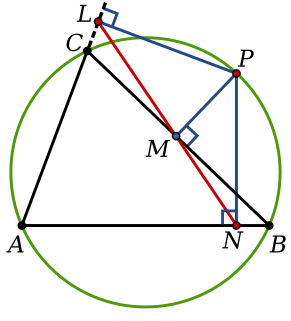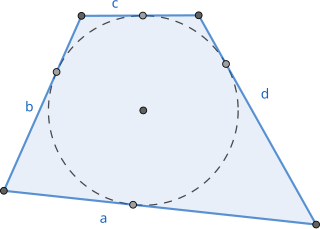Related Research Articles

In geometry a quadrilateral is a four-sided polygon, having four edges (sides) and four corners (vertices). The word is derived from the Latin words quadri, a variant of four, and latus, meaning "side". Another name for it is tetragon, derived from greek "tetra" meaning "four" and "gon" meaning "corner" or "angle", in analogy to e.g., pentagon. "Gon" being "angle" also is at the root of calling it quadrangle, 4-angle, in analogy to triangle. A quadrilateral with vertices , , and is sometimes denoted as .

In elementary geometry, two geometric objects are perpendicular if they intersect at a right angle.

In geometry, bisection is the division of something into two equal or congruent parts, usually by a line, which is then called a bisector. The most often considered types of bisectors are the segment bisector and the angle bisector.

In geometry, an altitude of a triangle is a line segment through a vertex and perpendicular to a line containing the base. This line containing the opposite side is called the extended base of the altitude. The intersection of the extended base and the altitude is called the foot of the altitude. The length of the altitude, often simply called "the altitude", is the distance between the extended base and the vertex. The process of drawing the altitude from the vertex to the foot is known as dropping the altitude at that vertex. It is a special case of orthogonal projection.

In geometry, the nine-point circle is a circle that can be constructed for any given triangle. It is so named because it passes through nine significant concyclic points defined from the triangle. These nine points are:

In geometry, the incircle or inscribed circle of a triangle is the largest circle contained in the triangle; it touches the three sides. The center of the incircle is a triangle center called the triangle's incenter.

In Euclidean geometry, a cyclic quadrilateral or inscribed quadrilateral is a quadrilateral whose vertices all lie on a single circle. This circle is called the circumcircle or circumscribed circle, and the vertices are said to be concyclic. The center of the circle and its radius are called the circumcenter and the circumradius respectively. Other names for these quadrilaterals are concyclic quadrilateral and chordal quadrilateral, the latter since the sides of the quadrilateral are chords of the circumcircle. Usually the quadrilateral is assumed to be convex, but there are also crossed cyclic quadrilaterals. The formulas and properties given below are valid in the convex case.

In geometry, the Euler line, named after Leonhard Euler, is a line determined from any triangle that is not equilateral. It is a central line of the triangle, and it passes through several important points determined from the triangle, including the orthocenter, the circumcenter, the centroid, the Exeter point and the center of the nine-point circle of the triangle.

In geometry, the midpoint is the middle point of a line segment. It is equidistant from both endpoints, and it is the centroid both of the segment and of the endpoints. It bisects the segment.

In geometry, a set of points are said to be concyclic if they lie on a common circle. All concyclic points are at the same distance from the center of the circle. Three points in the plane that do not all fall on a straight line are concyclic, but four or more such points in the plane are not necessarily concyclic.

In Euclidean geometry, a square is a regular quadrilateral, which means that it has four equal sides and four equal angles. It can also be defined as a rectangle with two equal-length adjacent sides. It is the only regular polygon whose internal angle, central angle, and external angle are all equal (90°), and whose diagonals are all equal in length. A square with vertices ABCD would be denoted ABCD.
In geometry, the semiperimeter of a polygon is half its perimeter. Although it has such a simple derivation from the perimeter, the semiperimeter appears frequently enough in formulas for triangles and other figures that it is given a separate name. When the semiperimeter occurs as part of a formula, it is typically denoted by the letter s.
In geometry, collinearity of a set of points is the property of their lying on a single line. A set of points with this property is said to be collinear. In greater generality, the term has been used for aligned objects, that is, things being "in a line" or "in a row".

In geometry, given a triangle ABC and a point P on its circumcircle, the three closest points to P on lines AB, AC, and BC are collinear. The line through these points is the Simson line of P, named for Robert Simson. The concept was first published, however, by William Wallace in 1799.

In geometry, a centre of an object is a point in some sense in the middle of the object. According to the specific definition of center taken into consideration, an object might have no center. If geometry is regarded as the study of isometry groups, then a center is a fixed point of all the isometries that move the object onto itself.

In Euclidean geometry, a tangential quadrilateral or circumscribed quadrilateral is a convex quadrilateral whose sides all can be tangent to a single circle within the quadrilateral. This circle is called the incircle of the quadrilateral or its inscribed circle, its center is the incenter and its radius is called the inradius. Since these quadrilaterals can be drawn surrounding or circumscribing their incircles, they have also been called circumscribable quadrilaterals, circumscribing quadrilaterals, and circumscriptible quadrilaterals. Tangential quadrilaterals are a special case of tangential polygons.
In triangle geometry, a circumconic is a conic section that passes through the three vertices of a triangle, and an inconic is a conic section inscribed in the sides, possibly extended, of a triangle.

In Euclidean geometry, a tangential polygon, also known as a circumscribed polygon, is a convex polygon that contains an inscribed circle. This is a circle that is tangent to each of the polygon's sides. The dual polygon of a tangential polygon is a cyclic polygon, which has a circumscribed circle passing through each of its vertices.

In plane geometry, an extended side or sideline of a polygon is the line that contains one side of the polygon. The extension of a side arises in various contexts.

In geometry, a mixtilinear incircle of a triangle is a circle tangent to two of its sides and internally tangent to its circumcircle. The mixtilinear incircle of a triangle tangent to the two sides containing vertex is called the -mixtilinear incircle. Every triangle has three unique mixtilinear incircles, one corresponding to each vertex.
References
- ↑ Dunn, J. A., and Pretty, J. E., "Halving a triangle," Mathematical Gazette 56, May 1972, 105-108.
- ↑ Kodokostas, Dimitrios, "Triangle Equalizers," Mathematics Magazine 83, April 2010, pp. 141-146.
- 1 2 Altshiller-Court, Nathan (2007) [1952], College Geometry: An Introduction to the Modern Geometry of the Triangle and the Circle (2nd ed.), Courier Dover, pp. 131, 137–8, ISBN 978-0-486-45805-2, OCLC 78063045
- ↑ Andreescu, Titu and Enescu, Bogdan, Mathematical Olympiad Treasures, Birkhäuser, 2006, pp. 64–68.
- ↑ Honsberger, Ross (1995), "4.2 Cyclic quadrilaterals", Episodes in Nineteenth and Twentieth Century Euclidean Geometry, New Mathematical Library, vol. 37, Cambridge University Press, pp. 35–39, ISBN 978-0-88385-639-0
- ↑ Weisstein, Eric W. "Maltitude". MathWorld .
- ↑ Cartensen, Jens, "About hexagons", Mathematical Spectrum 33(2) (2000-2001), 37-40.
- ↑ Nikolaos Dergiades, "Dao's theorem on six circumcenters associated with a cyclic hexagon", Forum Geometricorum 14, 2014, 243--246. http://forumgeom.fau.edu/FG2014volume14/FG201424index.html
- ↑ Leung, Kam-tim; and Suen, Suk-nam; "Vectors, matrices and geometry", Hong Kong University Press, 1994, pp. 53-54